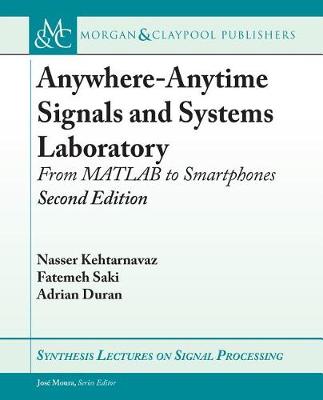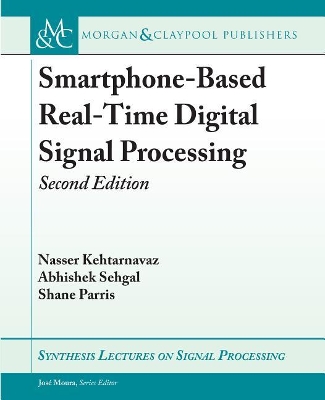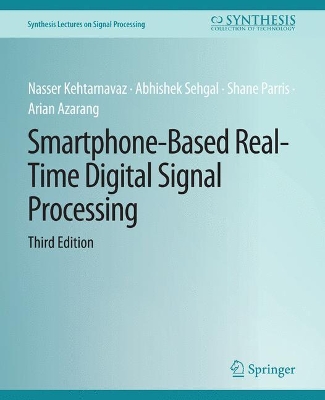Synthesis Lectures on Signal Processing
3 total works
Anywhere-Anytime Signals and Systems Laboratory
by Nasser Kehtarnavaz, Fatemeh Saki, and Adrian Duran
Published 1 October 2016
A typical undergraduate electrical engineering curriculum incorporates a signals and systems course. The widely used approach for the laboratory component of such courses involves the utilization of MATLAB to implement signals and systems concepts. This book presents a newly developed laboratory paradigm where MATLAB codes are made to run on smartphones, which most students already possess. This smartphone-based approach enables an anywhere-anytime platform for students to conduct signals and systems experiments. This book covers the laboratory experiments that are normally covered in signals and systems courses and discusses how to run MATLAB codes for these experiments on smartphones, thus enabling a truly mobile laboratory environment for students to learn the implementation aspects of signals and systems concepts. A zipped file of the codes discussed in the book can be acquired via the website.
Smartphone-Based Real-Time Digital Signal Processing
by Nasser Kehtarnavaz, Abhishek Sehgal, and Shane Parris
Published 1 August 2015
Real-time or applied digital signal processing courses are offered as follow-ups to conventional or theory-oriented digital signal processing courses in many engineering programs for the purpose of teaching students the technical know-how for putting signal processing algorithms or theory into practical use. These courses normally involve access to a teaching laboratory that is equipped with hardware boards, in particular DSP boards, together with their supporting software. A number of textbooks have been written discussing how to achieve real-time implementation on these hardware boards. This book discusses how smartphones can be used as hardware boards for real-time implementation of signal processing algorithms as an alternative to the hardware boards that are currently being used in signal processing teaching laboratories. The fact that mobile devices, in particular smartphones, have now become powerful processing platforms has led to the development of this book, thus enabling students to use their own smartphones to run signal processing algorithms in real-time considering that these days nearly all students possess smartphones. Changing the hardware platforms that are currently used in applied or real-time signal processing courses to smartphones creates a truly mobile laboratory experience or environment for students. In addition, it relieves the cost burden associated with using a dedicated signal processing board noting that the software development tools for smartphones are free of charge and are well-developed. This book is written in such a way that it can be used as a textbook for applied or real time digital signal processing courses offered at many universities. Ten lab experiments that are commonly encountered in such courses are covered in the book. This book is written primarily for those who are already familiar with signal processing concepts and are interested in their real-time and practical aspects. Similar to existing real-time courses, knowledge of C programming is assumed. This book can also be used as a self-study guide for those who wish to become familiar with signal processing app development on either Android or iPhone smartphones.
Smartphone-Based Real-Time Digital Signal Processing, Third Edition
by Abhishek Sehgal, Shane Parris, Arian Azarang, and Nasser Kehtarnavaz
Published 31 August 2020
Real-time or applied digital signal processing courses are offered as follow-ups to conventional or theory-oriented digital signal processing courses in many engineering programs for the purpose of teaching students the technical know-how for putting signal processing algorithms or theory into practical use. These courses normally involve access to a teaching laboratory that is equipped with hardware boards, in particular DSP boards, together with their supporting software. A number of textbooks have been written discussing how to achieve real-time implementation on these hardware boards. This book discusses how to use smartphones as hardware boards for real-time implementation of signal processing algorithms, thus providing an alternative to the hardware boards that are used in signal processing laboratory courses. The fact that mobile devices, in particular smartphones, have become powerful processing platforms led to the development of this book to enable students to use their own smartphones to run signal processing algorithms in real-time considering that these days nearly all students possess smartphones. Changing the hardware platforms that are currently used in applied or real-time signal processing courses to smartphones creates a truly flexible laboratory experience or environment for students. In addition, it relieves the cost burden associated with using dedicated signal processing boards noting that the software development tools for smartphones are free of charge and are well-maintained by smartphone manufacturers. This book is written in such a way that it can be used as a textbook for real-time or applied digital signal processing courses offered at many universities. Ten lab experiments that are commonly encountered in such courses are covered in the book. It is written primarily for those who are already familiar with signal processing concepts and are interested in their real-time and practical aspects. Similar to existing real-time courses, knowledge of C programming is assumed. This book can also be used as a self-study guide for those who wish to become familiar with signal processing app development on either Android or iOS smartphones/tablets.


